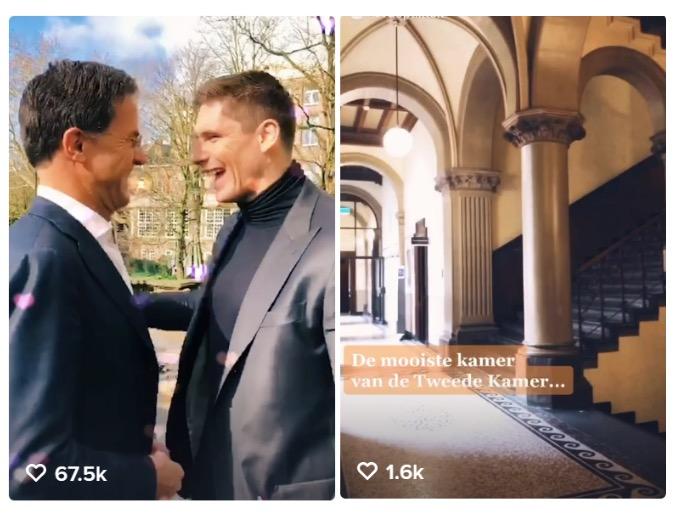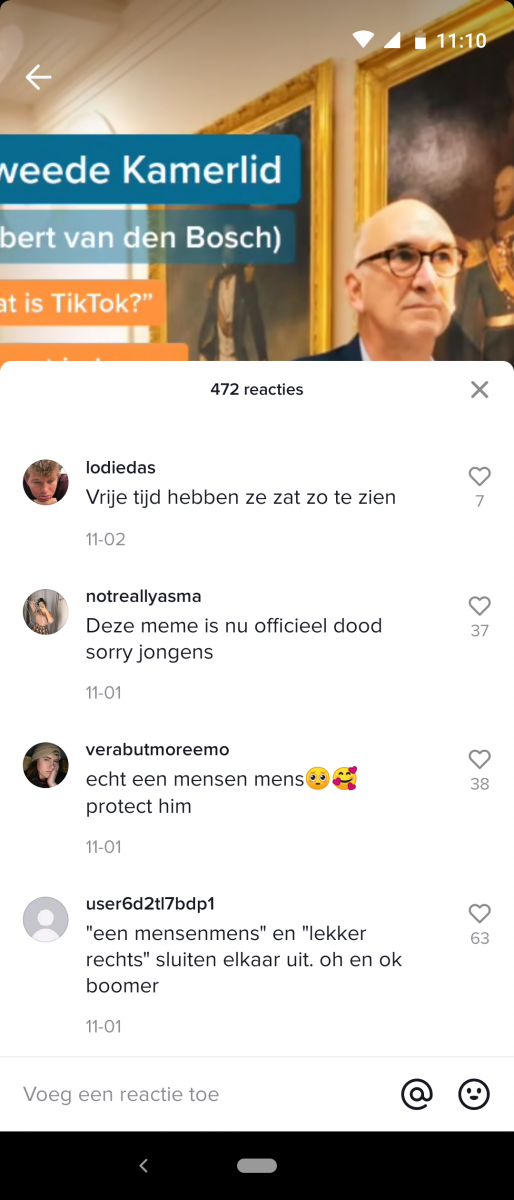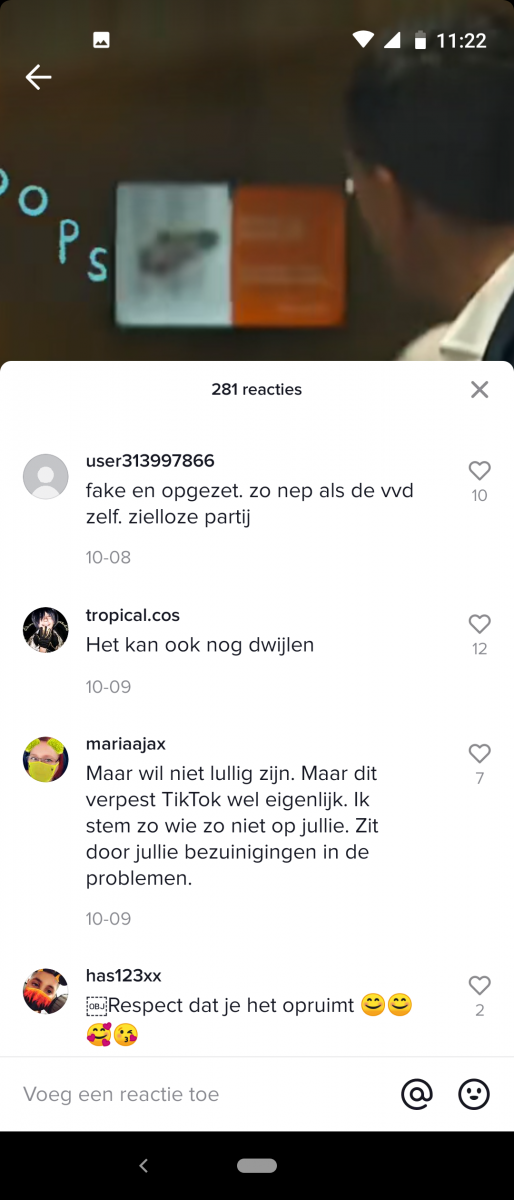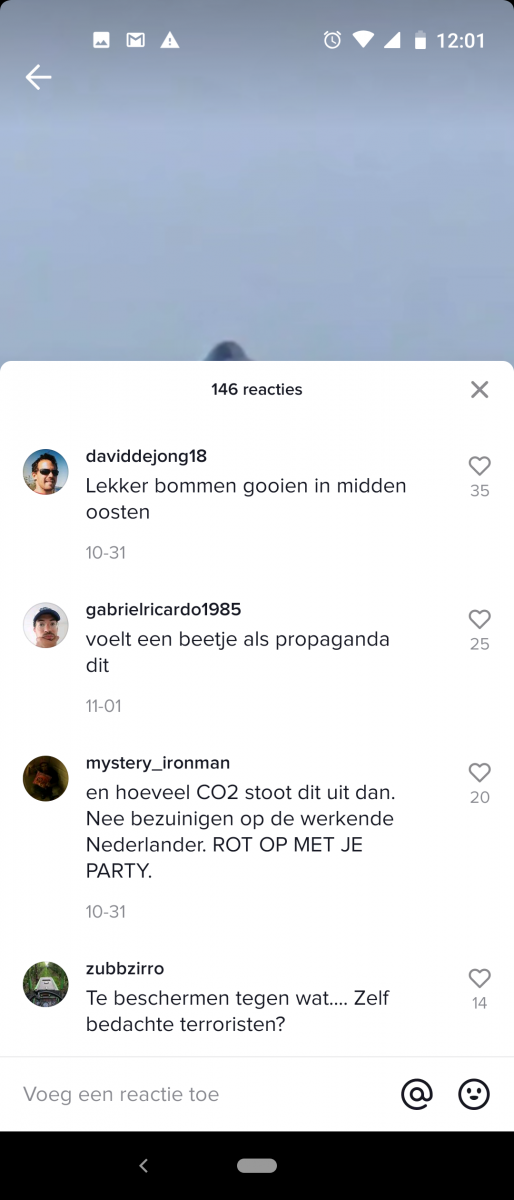
VVD on TikTok: Genuine connection or political stunt?
Imagine you are scrolling through the "For You" page on TikTok when all of sudden you see a post from Dutch political party VVD. What would your reaction be? Would you be intrigued to check out their videos? Or would you think TikTok is not a place for political content?
When the VVD joined the social media platform TikTok in October 2019, the Dutch media reacted by calling it "cringy" and "childish" (Engelbart, 2019; Massie, 2019). But the VVD TikTok comment section says otherwise: most teenagers seem to find it funny. But are they laughing with the VVD or are they laughing at it? (vvdoptiktok, 2019)
This article will explore how the VVD is trying to reach the youth on TikTok, by looking at how the party manages their image and message on the social media platform.
TikTok and VVD
In 2017, Chinese developer ByteDance launched a social media video app called TikTok. The app allowed users to create and share short music and lip-sync videos. In 2018, TikTok merged with the social media platform musical.ly - an app that was also about short lip-sync and comedy videos - to create a larger video community that would target the teenage market (Wikipedia, 2019a). And they succeeded: nowadays, TikTok is incredibly popular among teenagers. The app seems to be the perfect medium for the current generation, “a generation that grew up in a visual and digital culture, and who are used to filming themselves with their smartphones” (Verrycken, 2019).
The VVD is a Dutch political party and its initials stand for "Volkspartij voor Vrijheid en Democratie" (People’s Party for Freedom and Democracy). Their ideology is founded on conservative-liberal philosophy, promoting political, economic and cultural liberalism. In 2006, Mark Rutte became the party's leader. In 2010, he got promoted to Prime Minister of the Netherlands. Nowadays, the VVD is the biggest political party in the House of Representatives (VVD, 2019a. Wikipedia, 2019b).
VVD on TikTok, bio.
With 16,6k followers and 155k likes, the VVD is not doing badly on TikTok. Its TikTok bio reads: "we work towards a Netherlands with more freedom, more safety and more prosperity", which is a political statement connected to their party. Underneath, it says "VVD on TikTok". (Vvdoptiktok, 2019). Below, you see the first TikTok they posted. The caption reads "Our first TikTok. Mark (Rutte) is ready for it! Let's get it started in here!"
The likes on VVD's posts seem to range from 3k to 20k, with the exception of one video - featuring Dutch kickboxer and current Glory Heavyweight Champion Rico Verhoeven - which has 67k likes. The views range from 30k to 300k. On its TikTok account, the VVD posts short edited videos showing either political figures or behind-the-scenes content from the House of Representatives. Three people that seem to be dominating most of the TikToks are: Mark Rutte (Prime Minister of the Netherlands and leader of the VVD), Klaas Dijkhoff (VVD Leader in the House of Representatives), and Albert van den Bosch (member of the VVD).
Albert van den Bosch on TikTok.
The VVD TikToks are (in)directly political. They show funny moments of Mark Rutte biking around, having a stare-off with Rico Verhoeven, sharing a joke with Willem-Alexander (King of the Netherlands), or spilling a cup of coffee on the floor. These videos do not explicitly make a political statement for the VVD, but they do carry a lot of other messages with them: Mark Rutte is a "man of the people" who goes to work on a bike or cleans up his own spilled coffee. At the same time, it shows that Rutte knows important people, like celebrities and the King.
Message politics in a hybrid media system
Political parties want to be relevant. Whereas the political information cycle used to be the daily period between the latest and newest newspaper, it has now turned into a 24/7 news production cycle with news articles having a certain lifespan. Something is relevant or "hot" for a certain amount of time and in that lifespan, politicians try to gain influence. TikTok is an increasingly popular app, and therefore it is logical that the VVD is trying to gain some influence and attention on it.
But TikTok does not just provide influence on anyone: it has influence on teenagers. User statistics show that TikTok has 500 million active users worldwide every month. And 41% of TikTok users are aged between 16 and 24. This is not unexpected since the TikTok creators chose "under 18" as their target audience when designing the app. We also know that the average TikTok user spends 52 minutes per day on the app, and that they open the app more than once every day (Mohsin, 2019). This means that the VVD videos have a chance of reaching the youth on a daily basis, through a vehicle that the youth actually enjoys. That is, through funny videos instead of straight-forward political advertisements.
Of course, in order to appeal to these potential future voters, the VVD must construct a message within that medium which successfully addresses this audience. That would be a message that matches the dusty image of a political party with the new, young TikTok culture, in which it has to fit. In other words, the party must re-style its communication to match the media logic (Chadwick, Dennis, Smith, 2016) of TikTok.
In order to communicate effectively to teenagers on TikTok, knowledge of the media field and media logic is crucial.
Chadwick and colleagues (2016) talk about the hybrid media system and how the social fields of media and politics influence each other. Nowadays, political discourse needs to fit into the media format. It needs to be short, exciting, and clickbaity (Chadwick, Dennis, Smith, 2016). The dry political speech of Parliament will no longer work for the teenagers on TikTok; instead, the party's communication needs to be adjusted to the logic and culture of the platform. We see that in times of digitalization, political action is no longer only about message politics (one's input), but also about media literacy (Maly, 2018). Knowing the media logic is crucial for uptake: you want for people to like, comment, and share your posts (and thus your message). The VVD must gain knowledge about what is normal behaviour on TikTok: what kind of language is acceptable, which videos/memes/trends are popular, which hashtags attract people, etc.
When it comes to hashtags for example, we see that the VVD uses #fyp under every TikTok. This is a popular TikTok hashtag and means "for your page". It refers to the app’s "For You" page, which is filled with TikToks that the app (algorithmically) selects for you. Almost every TikTok user uses this hashtag, because by adding #fyp to your caption, the platform TikTok is more likely to consider your TikToks and recommend them to (new) people. This way, TikTok users can expand their audience (Rosenberg, 2019). Understanding which hashtags are effective is part of understanding the media logic in a field. More specific hashtags like #markrutte and #vvd are less succesfull.
VVD hashtags.
Knowing the media logic is also important for producing the right message. Every single time the VVD communicates on TikTok, it needs to be "on message". “Being ‘on message’ contributes to that consistent, cumulative, and consequential image that a public persona has among his or her addressed audience” (Silverstein, 2003). This means that the VVD needs to consistently communicate a specific aura and a "realness" that appeals to its target audience. TikTok enables a non-direct way of being political with teenagers. But only if the VVD can communicate its message in the "right" and "normal" way, can it portray itself as a "relevant" and "relatable" party. When trying to be ‘on message’ for teenagers, uptake seems to be dependent on how funny - instead of how political - a TikTok is. The video of Mark Rutte and Rico Verhoeven having a stare-off has the most likes and views of all the VVD TikToks (67.5k likes), while a video showing a room in the House of Representatives gets less attention (1.65k likes; see screenshots below).

A popular and less popular post on TikTok
The question is: how does the VVD create an accepted (by the youth) image of themselves on TikTok? And can they do so without being categorized as laughable and ludicrous by the teenage TikTok users?
VVD message politics on TikTok: targeting youth and getting personal
The VVD's message on TikTok seems to be that they want to get personal with teenagers. For example, they show behind-the-scenes footage and create TikToks to introduce members of the political party. One way to target the youth, is by using the same (trending) memes as they do. Because then, not only does your message needs to resonate with the TikTok users, it also needs to align with the spirit of the times.
Below, you see a screenshot of a TikTok in which Albert van den Bosch presents himself in a meme-like way. Examples of things he says about himself are: "wants to have a conversation with everyone", "right-wing", and "always wants to change the Constitution". By putting the information in a meme's context, political information gets communicated to the TikTok youth without it feeling extremely political.
Albert van den Bosch introduces himself.
But, there is an interesting relation here between how the VVD intended the video to be like and how it got picked up. For the VVD, it was meant as a funny way to share information about van den Bosch and what he stands for. For some teenagers, this worked: comments include "lmfao" and "hahaha he's the boss".
But for others, the post was seen as weird or outdated. People comment saying that the meme is "too old" or that the VVD is not doing it the right way. One of the words that Albert uses to describe himself is "ondeugend", which can mean both frolicsome or naughty. The VVD of course intended to say that Albert - despite the fact that he is old - is still lively and playful. But the TikTok users just make fun of it and interpret it as "naughty", probably in a more sexual way.

Comments under Albert's meme.
Other comments say things like "genius" and "protect this guy". But there are also comments like "seems like the VVD has enough free time", "this meme is officially dead, sorry guys", "ok boomer", and "when politics tries to reach the youth...".
The comment "ok boomer" is especially interesting, because it says a lot about how teenagers view this TikTok. "Ok boomer" is a popular internet meme that gained popularity among teenagers in 2019. It is directed towards the baby boomer generation, and it is used to dismiss or mock attitudes (Wikipedia, 2019c). In this case, "ok boomer" is used to mock van den Bosch and how he uses the meme. Not only is it no longer a trending meme, but van den Bosch also does not use it in the right way.
Another interesting element to look at is how the VVD is framing itself on TikTok: what is the persona they are building online? It seems as if the VVD wants to frame itself as a party "of the people": they want to show that they are just like us. There is a "chill" and "fun" vibe in their videos, showing a "youthful" VVD. We can see this in the TikTok where Mark Rutte spills his coffee. It is meant to be funny: "look at me, I spilled coffee all over the floor, I’m not perfect". But it also shows that Rutte cleans up after himself: he mops the floor while laughing at how silly he was to spill the coffee in the first place. Again, the comment section is filled with diverse reactions. Some find it funny, some find it uninteresting, but most see right through it. The teenagers understand what the VVD wants to achieve - what kind of message they want to communicate - and they are not here for it.

Comments under the coffee TikTok.
The comments say: "fake and staged, as fake as the VVD itself, what a soulless party", "don't want to be rude, but this is ruining tiktok, i wasn't gonna vote for you anyway", "haha do you get it? he is cleaning his own coffee. interesting, because normally you never see this" and "please don't pretend he is a normal person". TikToks like these show that there is a difference between the input of the VVD (their intention with the TikTok) and the uptake of teenagers (the way the TikTok is received). This brings us to the issue of uptake and backlash.
Uptake and backlash
As mentioned above, being on TikTok means that the VVD has to adjust their communication. This adjustment comes with all kinds of difficulties and effects. For one, you need to still be believable. It seems to be the case that the VVD message is missing genuineness: the party is not on TikTok because they enjoy seeing how creative other TikTok users get, or to communicate with their audience. Instead, they are on TikTok because of political reasons. And the teenagers see right through them. On the Albert meme I discussed above,there are also comments like: "when you cannot be relevant for the youth, so you join tiktok", "when is the pvv [another Dutch political party] joining tiktok?", and "i'm still confused about the fact that the VVD is on TikTok" (see screenshot below). The relatability factor is aimed at by the VVD, but not picked up by teenagers that way. The TikTok youth do not relate with the VVD; instead, they laugh at them.
Still, it can get worse than just being laughed at. Uptake can completely deviate from input, even due to small details like the choice of background music. A TikTok about the arrival of the first Dutch fighter aircraft F-35 shows that the VVD supports this aircraft and sees it as a "the jet-fighter of the future" that will protect us all. (VVD, 2019b). It is a political statement, formatted in a funny TikTok kind of way.
The Dutch song used in the backgorund is by Dutch singer Dries Roelvink. The song is called Ik kom eraan (Youtube, 2009), which translates to "I will arrive". Given the fact that the arrival of the plane is a controversial theme, adding a "fun" song to the background can be a small detail that will get you "off message". It shows the need to carefully construct one's message, because the comment section is filled with negative reactions. People critique the VVD support of the plane and appear pretty angry.

Comment section under TikTok video.
These screenshots show only a small part of the negative comments. The comments say things like "just throwing bombs in the middle east", "this feels like propaganda", "think of the CO2 emissions, go away with your political party" and "this will protect us against who? self-invented terrorists?". In general, the uptake appears to mostly be that teenagers find VVD on TikTok ludicrous. There are some genuine reactions where people think it is nice that the VVD is active on TikTok, but a rough 90% of the comments are just teenagers laughing at the VVD trying to be trendy and relevant. The thing is, the VVD probably did not want this for their outing on TikTok - they might have hoped to be taken seriously on the medium - but they still have reached a teenage audience and have gained visibility. Their videos might lack authenticity and feel like political advertisements, but they still get viewed, liked, and commented upon.
VVD on TikTok
In the hybrid media system, being on or off message is a complex bussiness where attention to detail is needed. Using a meme that is too old or choosing the wrong music means you no longer fit into the TikTok culture. Digital literacy is needed: in order to reach the TikTok teenagers, you need to both gain knowledge of your audience and understand how the social media platform of TikTok works.
Message production is always done in a social, economic, political and historical context. A good politician constructs meaning that resonates with the spirit of the times. In the age of digitalization, it is crucial to understand that technologies shape contexts of their own, they have their own media logic and their own cultures. The VVD thus needs to reorganize its message so that is resonates with and addresses an audience in a new context, without deconstructing their messages in other niches of the contemporary media field.
When the VVD joined TikTok, it generated varying reactions. It showed that message politics is both about input and about uptake. A lot of teenagers find it funny, but their reaction comes closer to laughing at the party's expense than genuinely laughing. Their TikToks are picked up as cringy instead of TikTok-worthy as their reasons for being on TikTok are not genuine.
Nevertheless, VVD has gained an audience on TikTok that continues to watch their videos, and thus the visibility of the party and its political figures grows. Through TikTok, the VVD can interact with the youth in a more playful way. These teenagers - due to TikTok - know what the political members of the VVD look like, their names, and what they stand for. It might seem as if the VVD is trying too hard, but at least they are trying - and while doing so, reaching future voters.
References
Chadwick, A. Dennis, J. Smith, A.P. (2016). Politics in the age of hybrid media: power, systems, and media logics. In Axel Bruns, Gunn Enli, Eli Skogerbø, Anders Olof Larsson, and Christian Christensen (eds). The Routledge companion to social media and politics.
Engelbart, T. (2019). Kinderachtige VVD maakt ultradom TikTok-filmpje met Klaas Dijkhoff: ‘Beste vriend van Thierry Baudet? Nope!’ Dagelijksestandaard.nl
Maly, I. (2018). Populism as a mediatized communicative relation: the birth of algorithmic populism. Tilburg University.
Massie. (2019). Cringe much: ook de VVD zit nu op TikTok. Skoften.net
Mohsin, M. (2019). 10 TikTok statistics that you need to know in 2019. Oberlo.com
Rosenberg, L. (2019). This is why TikTok users comment #fyp on other people’s videos. Distractify.com
Silverstein, M. (2003). Talking Politics, The substance of style from Abe to W. Prickly Paradigm Press.
Verrycken, R. (2019). Welkom in de wereld van TikTok. Tijd.be
VVD. (2019b). Eerste F-35 in Nederland. Vvd.nl
VVD. (2019b). Standpunt Straaljagers. Vvd.nl
VVD. (2019a). Volkspartij voor Vrijheid en Democratie. Vvd.nl
Vvdoptiktok. (2019). VVD account. Tiktok.com
Wikipedia. (2019c). Ok boomer. Wikipedia.org
Wikipedia. (2019b). People’s party for Freedom and Democracy. Wikipedia.org
Wikipedia. (2019a). TikTok. Wikipedia.org
Youtube. (2009). Dries Roelvink - Ik kom eraan. Youtube.com